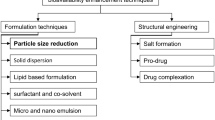Abstract
The solubility advantage of indomethacin amorphized by co-grinding with Neusilin US2 in various media was investigated. Physical mixtures of γ-indomethacin and Neusilin US2 (in the ratios 1:1, 1:4 and 1:5) were amorphized at room temperature employing 75% RH in a porcelain jar mill using zirconia balls. The crystallinity of the samples was determined using ATR-FTIR and PXRD. The solubility and dissolution profiles of co-ground powders and crystalline counterparts were evaluated in 0.1 N HCl, water and phosphate buffer (pH 6.8) in a USP type II dissolution apparatus at 250 rpm and 37 °C. Very high concentrations of dissolved indomethacin as compared to the solubility of γ-indomethacin (~500 times in water and ~ 3.7 times in phosphate buffer) were attained. However, the presence of other polymorphs detected by PXRD and a change in the pH of the medium made interpretation of the results difficult. In 0.1 N HCl the solubility (i.e., the peak in a concentration versus time plot) of the amorphized drug in a 1:5 ratio with Neusilin increased to 109 times the solubility of crystalline γ-indomethacin alone. An increase in amount of drug and Neusilin in the same ratio added to the dissolution medium also increased peak and plateau dissolution concentrations. The presence of silicic acid and ions (Mg2+ and Al3+) in the dissolution media were found to cause the increase in the plateau concentration of indomethacin. Amorphization alone does not account for all of the dissolution enhancement; acidity, ions, and silicic acid are major contributors to dissolution enhancement.









Similar content being viewed by others
References
B. C. Hancock, and G. Zografi. Characteristics and significance of the amorphous state in pharmaceutical systems. J. Pharm. Sci. 861:1–12 (1997).
W. L. Chiou, and S. Riegelman. Pharmaceutical applications of solid dispersion systems. J. Pharm. Sci. 609:1281–1302 (1971).
B. C. Hancock, and M. Parks. What is the true solubility advantage for amorphous pharmaceuticals? Pharma. Res. 174:397–404 (2000).
M. Kinoshita, K. Baba, A. Nagayasu, K. Yamabe, T. Shimooka, Y. I. Takeichi, M. Azuma, H. Houchi, and K. Minakuchi. Improvement of solubility and oral bioavailability of a poorly water-soluble drug, TAS-301, by its melt-adsorption on a porous calcium silicate. J. Pharm. Sci. 912:362–370 (2002).
T. Watanabe, S. Hasegawa, N. Wakiyama, A. Kusai, and M. Senna. Prediction of apparent equilibrium solubility of indomethacin compounded with silica by 13C solid state NMR. Int. J. Pharm. 2481–2:123–129 (2002).
T. Watanabe, S. Hasegawa, N. Wakiyama, A. Kusai, and M. Senna. Comparison between polyvinylpyrrolidone and silica nanoparticles as carriers for indomethacin in a solid state dispersion. Int. J. Pharm. 2501:283–286 (2003).
D. Law, E. A. Schmitt, K. C. Marsh, E. A. Everitt, W. Wang, J. J. Fort, S. L. Krill, and Y. Qiu. Ritonavir-PEG 8000 amorphous solid dispersions: in vitro and in vivo evaluations. J. Pharm. Sci. 933:563–570 (2004).
T. Watanabe, N. Wakiyama, F. Usui, M. Ikeda, T. Isobe, and M. Senna. Stability of amorphous indomethacin compounded with silica. Int. J. Pharm. 2261–2:81–91 (2001).
P. Tong, and G. Zografi. A study of amorphous molecular dispersions of indomethacin and its sodium salt. J. Pharm. Sci. 9012:1991–2004 (2001).
A. E. H. Gassim, P. G. Takla, and K. C. James. Polymorphism and possible intramolecular bonding in benperidol. Int. J. Pharm. 341–2:23–28 (1986).
E. Nuernberg, and A. Hopp. Pharmaceutical studies of paracetamol. 2. Differential thermal analytical studies. Pharm. Ind. 451:85–87 (1983).
K. Y. Yang, R. Glemza, and C. I. Jarowski. Effects of amorphous silicon dioxides on drug dissolution. J. Pharm. Sci. 685:560–565 (1979).
P. Tong, and G. Zografi. Solid-state characteristics of amorphous sodium indomethacin relative to its free acid. Pharma Res. 168:1186–1192 (1999).
E. Yonemochi, S. Kitahara, S. Maeda, S. Yamamura, T. Oguchi, and K. Yamamoto. Physicochemical properties of amorphous clarithromycin obtained by grinding and spray drying. Eur. J. Pharm. Sci. 74:331–338 (1999).
H. Takeuchi, S. Nagira, H. Yamamoto, and Y. Kawashima. Solid dispersion particles of amorphous indomethacin with fine porous silica particles by using spray-drying method. Int. J. Pharm. 2931–2:155–164 (2005).
M. Ohta, and G. Buckton. A study of the differences between two amorphous spray-dried samples of cefditoren pivoxil which exhibited different physical stabilities. Int. J. Pharm. 2891–2:31–38 (2005).
D. J. Van Drooge, W. L. J. Hinrichs, H. W. Frijlink, G. S. Zijlstra, and B. H. J. Dickhoff. A process for preparing formulations of lipophilic active substances by spray freeze drying. 2005-EP55805, 2006051067, 20051108 (2006).
V. V. Boldyrev, T. P. Shakhtshneider, L. P. Burleva, and V. A. Severtsev. Preparation of the disperse systems of sulfathiazole–poly(vinylpyrrolidone) by mechanical activation. Drug Dev. Ind. Pharm. 206:1103–1114 (1994).
F. Forni, G. Coppi, V. Iannuccelli, M. A. Vandelli, and M. T. Bernabei. Solid state transitions and CAP availability in surface solid dispersions of chloramphenicol stearate polymorphs. Drug Dev. Ind. Pharm. 145:633–647 (1988).
E. Yonemochi, M. Matsumura, T. Oguchi, K. Yamamoto, and Y. Nakai. Interactions of medicinals and porous powder. VI. Stability of aspirin in controlled pore glass solid dispersions. Chem. Pharm. Bull. 394:1027–1031 (1991).
M. K. Gupta, A. Vanwert, and R. H. Bogner. Formation of physically stable amorphous drugs by milling with neusilin. J. Pharm. Sci. 923:536–551 (2003).
T. Konno, K. Kinuno, and K. Kataoka. Physical and chemical changes of medicinals in mixtures with adsorbents in the solid state. I. Effect of vapor pressure of the medicinals on changes in crystalline properties. Chem. Pharm. Bull. 341:301–307 (1986).
K. H. Kim, M. J. Frank, and N. L. Henderson. Application of differential scanning calorimetry to the study of solid drug dispersions. J. Pharm. Sci. 743:283–289 (1985).
L. Wang, F.-D. Cui, and H. Sunada. Preparation and evaluation of solid dispersions of nitrendipine prepared with fine silica particles using the melt-mixing method. Chem. Pharm. Bull. 541:37–43 (2006).
H. Takeuchi, S. Nagira, H. Yamamoto, and Y. Kawashima. Solid dispersion particles of tolbutamide prepared with fine silica particles by the spray-drying method. Powder Technol. 1413:187–195 (2004).
A. M. El-Sayed, A. S. Ali, and A. A. Assi. Enhancing the pharmacological effect of phenytoin using porous silica as carrier. STP Pharma 34:319–324 (1993).
A. E. Aboutaleb, A. A. Abdel-Rahman, M. O. Ahmed, and U. S. A. Uwaida. Enhancement of dissolution rate of meclozine HCl by co-grinding and loading onto certain adsorbents. Bull. Pharm. Sci. Assiut Univ. 251:7–14 (2002).
D. Bahl, and R. H. Bogner. Amorphization of indomethacin by co-grinding with Neusilin US2: amorphization kinetics, physical stability and mechanism. Pharm. Res. 2310:2317–2325 (2006).
M. O’Brien, J. McCauley, and E. Cohen. Indomethacin. In H. G. Brittain (ed.), Analytical Profiles of Drug Substances, 13:Academic, London, UK, 1984, pp. 211–238.
R. K. Iler. The Chemistry of Silica: Solubility, Polymerization, Colloid and Surface Properties and Biochemistry, Wiley, New York, 1979, p 892.
M. Mosharraf, and C. Nystrom. The effect of dry mixing on the apparent solubility of hydrophobic, sparingly soluble drugs. Eur. J. Pharm. Sci. 92:145–156 (1999).
M. Kinoshita, K. Baba, A. Nagayasu, K. Yamabe, M. Azuma, H. Houchi, and K. Minakuchi. Highly stabilized amorphous 3-bis(4-methoxyphenyl)methylene-2-indolinone (TAS-301) in melt-adsorbed products with silicate compounds. Drug Dev. Ind. Pharm. 295:523–529 (2003).
Z. Wang, L. S. Burrell, and W. J. Lambert. Solubility of E2050 at various pH: a case in which apparent solubility is affected by the amount of excess solid. J. Pharm. Sci. 916:1445–1455 (2002).
K. Kawakami, K. Miyoshi, and Y. Ida. Impact of the amount of excess solids on apparent solubility. Pharm. Res. 229:1537–1543 (2005).
E. M. Phillips, and P. R. Byron. Surfactant promoted crystal growth of micronized methylprednisolone in trichloromonofluoromethane. Int. J. Pharm. 1101:9–19 (1994).
M. Mosharraf, and C. Nystrom. Apparent solubility of drugs in partially crystalline systems. Drug Dev. Ind. Pharm. 296:603–622 (2003).
Acknowledgements
The financial support from the Dane O. Kildsig Center for Pharmaceutical Processing Research and from Fuji Chemicals is gratefully acknowledged. Dr. Isabelle Lagadic (Department of Chemistry) and Mr. Gary Lavigne (Institute of Material Sciences) at the University of Connecticut kindly assisted with X-ray diffractometer and FTIR instrument, respectively. Mr. Sharad Murdande performed the HPLC analysis.
Author information
Authors and Affiliations
Corresponding author
Rights and permissions
About this article
Cite this article
Bahl, D., Bogner, R.H. Amorphization Alone Does Not Account for the Enhancement of Solubility of Drug Co-ground with Silicate: The Case of Indomethacin. AAPS PharmSciTech 9, 146–153 (2008). https://doi.org/10.1208/s12249-007-9013-9
Received:
Accepted:
Published:
Issue Date:
DOI: https://doi.org/10.1208/s12249-007-9013-9




